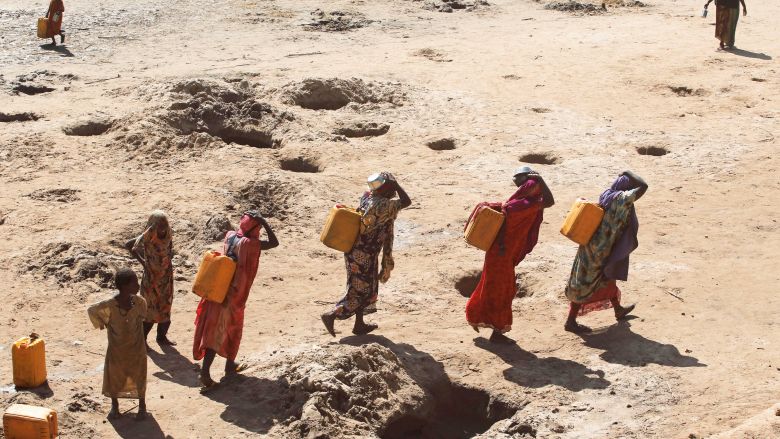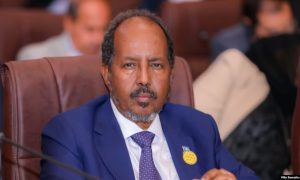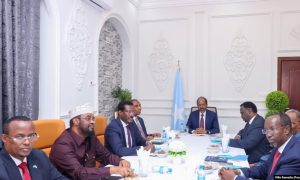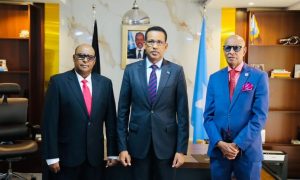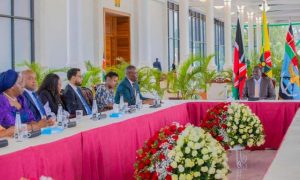
Women carry jerry cans of water from shallow wells dug from the sand along the Shabelle River bed, which is dry due to drought in Somalia’s Shabelle region, March 19. REUTERS/Feisal Omar.
NEWSWEEK | April 13, 2016 | By Sagal Abshir |
Drought-hit Somalia reaches a tipping point |
Fatima Jibrell’s bleak outlook is evident. “We have no drinking water in Badhan today.” For the pastoralists of Somalia, only dirty, expensive water is for sale, brought in over dirt roads by truck in the scorching heat. Not a single one of the four boreholes in her small village are working.
There is a drought in the Horn of Africa. Four successive rains have failed.
Jibrell, an award-winning environmental activist, has the wise commanding presence of an elder and the shining eyes of an idealist. She is also a date farmer in Badhan, a small village 40 kilometers away from the Gulf of Aden, about halfway between Djibouti to the west and the tip of the Horn of Africa to the east. It abuts a region claimed both by Puntland State of Somalia to its right, and by the independence-seeking region of Somaliland to its left. But at this moment, borders and politics do not matter.
We know this movie, we’ve seen this play—the imagery and narrative evoked by the word ‘drought’ in this region are uncomfortably familiar. There are miles of parched landscape, animal carcasses, emaciated children with distended bellies—and flies everywhere. But this is to misunderstand drought, or to get ahead of our story.
You have to imagine we are backstage, or a few scenes earlier in this potentially tragic tale.
Drought does not mean famine. Drought does not even necessarily mean no rain at all. Drought, explains water engineer Mohamud Mohamed Ali drily, is “sequential precipitation deficiency,” meaning less than average rainfall for extended periods of time. It is a natural phenomenon that happens all the time. Even California is entering its fourth year of a record-breaking drought.
Ali was the director of the Department of Irrigation and Land Use in the Ministry of Agriculture until the state collapsed in 1991. Northern Somalia, he says, is particularly geographically disadvantaged when it comes to rainfall. The entire region, starting from eastern Ethiopia, parts of Eritrea, Djibouti and northern Somalia are on the windward side of the Ethiopian highlands, sheltered from the south-westerly wind that brings rain from the Atlantic. Add to this the increased frequency and intensity of extreme weather events, such as the infamous El-Nino event, and droughts are a common affair.
“In fact,” adds Ali, “nomadic pastoralism is the response to the harsh environment, developed over time to make the best use of the arid land and the erratic rainfall.” The key to this lifestyle is the constant movement that allows the pastoralists to find food and water for their livestock by moving from place to place during the different seasons, allowing the water points and trees to replenish in their absence. Over 60 percent of all Somalis rely on a pastoral or a semi-pastoral lifestyle, and drought forms part and parcel of their reality, to which they adapt, and keep moving.
Drought does not mean famine, but it can lead to it. But what turns a drought from a weather incident to a massive humanitarian disaster? It generally hinges on a combination of factors, including the intensity and duration of the drought, the aridity of the land, the vulnerability of the population, the resilience of their coping mechanisms, and more recently in our times, the ability of humanitarian actors to intervene.
The relevant concept is food security—or food insecurity—the ability or inability of people to have access to adequate affordable food. Famine is the most acute manifestation of food insecurity. The severity of food insecurity is described by a globally accepted five-stage Integrated Food Security Phase Classification, or the IPC scale which goes: Minimal, Stressed, Crisis, Emergency and, Famine. In Somalia, “over 1 million people are currently in Crisis and Emergency (IPC Phases 3 and 4),” reported the Famine Early Warning Systems Network (FEWS NET) in early 2016.
We are still backstage, and the script is hastily being altered. Can famine be averted?
The simple plot-line is to take action before the situation worsens and turns into an IPC Phase 5, Famine. For the pastoralist, our hero, this means moving, seeking pastures further and further away and buying water and grain where he can afford it. It also means making tough decisions about selling some of his livestock before they get too weak to fetch a decent price. “Four months ago, the pastoralists moved from here south to Burao and Las Anod and Nugaal,” explains Jibrell. She’s concerned that the drought will catch up with them, and they will venture even further, to pastures more distant from better-known areas. If their animals die while they are out in remote hinterlands, they will not be able to afford to return to their homelands and will end up in camps for the displaced. Meanwhile, other pastoralists have moved from Ethiopia and other areas to the Awdal region of Somaliland, near the Djibouti border, because there was some rain at the end of 2015. Word spreads fast when rain falls anywhere.
For the governments and humanitarian communities—our supporting actors—it means using all the early warning data generated by organizations like FEWS NET to take early action.
Early action, explains Richard Trenchard, head of the U.N. Food and Agriculture Organization (FAO), in this case means trucking water to these communities, supporting the few wells and boreholes, fixing pumps, bringing in diesel, and building water catchment systems so that the few drops of precious rain do not disappear into the dusty ground. Early action means getting cash into people’s pockets through cash-for-work programs, so they can buy food for their families without selling the livestock; stockpiling drugs and vaccines for livestock in case there is a drought-related outbreak.
However, all of this costs money. And in many cases, early action means getting the attention of the world; the donors who will pay, the well-wishers who will contribute and the non-governmental organizations who will help. It also means that it’s important to alert relatives who will send money from the diaspora. But all this must be done at the right time, and in the right way.
.
.
_________________________
_____________________________________________________________________________________
Xafiiska Wararka Qaranimo Online | Mogadishu, Somalia
_____________________________________________________________________________________Advertisement
_____________________________________________________________________________________


